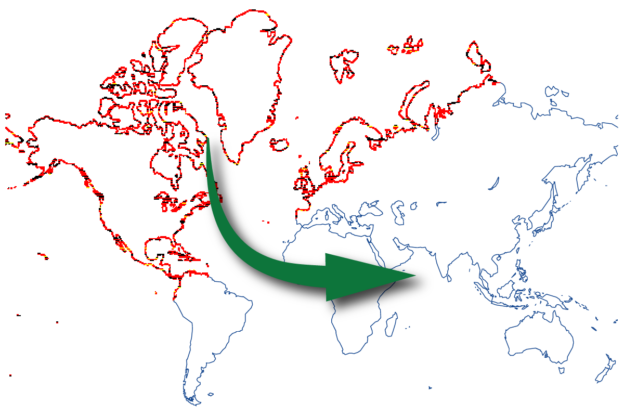OpenStreetMap will take a large leap forward with the introduction of vector tiles on openstreetmap.org this year. This is the first of a series of blog posts where we will share our progress.
To lead our vector tiles project, the OpenStreetMap Foundation has hired Paul Norman, a renowned figure in cartography and open data, whose journey with OpenStreetMap began in 2010 with a chance encounter on the xkcd forums. His role in the community took off with his work on OpenStreetMap Carto in 2013. His volunteer involvement with the OSM Foundation, including contributions to several working groups and a tenure on the OSMF board, highlights his commitment to the project. Professionally, he has held various influential positions at MapQuest, CartoDB, Wikimedia Foundation, and Amazon. Billions have seen the products of his work. To read more from Paul, visit his blog for technical deep dives into vector tiles, follow him on Mastodon or on Twitter.
Vector tiles represent a significant advancement in how map data is processed and presented. Unlike traditional raster tiles, which are static images with pixels, vector tiles are like the ‘SVGs’ of the mapping world: you get lines and points. This stores geodata in a format that allows for dynamic styling and interactivity, enabling the user to adapt the visual appearance of the map without altering the data. If that sounds like what you’ve seen on other maps, you are right! Vector tiles have become industry standard in interactive maps that, unlike openstreetmap.org, don’t get updated often, and where you can simply recalculate your whole database occasionally.
But the map displayed on openstreetmap.org are quite uniquely different! They get updated incrementally and constantly, a minute after you edit; it’s a critical part of the feedback loop to mappers – and how the author of this blog post got hooked in the first place. This is why we have to invest in our own vector tile software stack.
In the direct future, for users, this will mean a new, modern-looking map style with seamless zoom on openstreetmap.org. Looking further ahead, the most exciting part is what this vector tile project will make easy for volunteers and tile users: 3d maps, more efficient data mixing and matching and integration of other datasets, thematic styles, multilingual maps, different views for administrative boundaries, interactive points of interest, more accessible maps for vision-impaired users, and I’m sure many other ideas that no one has come up with yet. This technology is not just a leap in aesthetics, but also in functionality, enhancing the overall user experience.
In the 2021 community survey (page 15), there was no clear sentiment on what the foundation should do on vector tiles. We noticed a split in preferences: some advocated for volunteer-led development, others for professional engagement. The ecosystem has evolved since then, making it easier to build on top of existing software bricks. We see our project as a reasonable balance between the two most popular answers. Investing in core software is also part of our multi-year strategic plan.
The OpenStreetMap Foundation depends on donations to finish this project. If you would like to support our year of vector tiles specifically, you can donate and leave ‘vector tiles’ in the donation message. Every contribution, large or small, directly supports our ability to ensure that OpenStreetMap can be open, accessible and dynamic for all. Your support is not just a donation; it’s an investment in the future of open-source mapping.
We’re just at the beginning of this exciting journey. Stay tuned as we will delve deeper into the schema and style aspects in future blog posts.
This post is also available in: French German Japanese Spanish Arabic


Do you think it will be possible for users to export svg maps for use in digital art work / 3d printing etc? That would be awesome!
@andy you can check out the options on https://wiki.openstreetmap.org/wiki/SVG or the Figma Placemark plugin https://www.figma.com/community/plugin/1189962635826293304/placemark
Nice!
It seems obvious that vector based maps make the most sense. A low powered device with fast and large storage may find raster maps better, but most map display devices don’t really lack for power as much as they would struggle with many gigabytes of raster maps. Add the frequent updates of OSM and it becomes untenable. I think vector tiles is the way to go and makes more interesting features possible while also future proofing.
Will OSM abolish the former raster tiles? Because after all, we have too many users who may need to maintain compatibility, and raster tiles still have advantages on mobile devices that do not have good webgl support or need to save power. I hope this revolution will not be too sudden but will last long enough for users to choose.
Of course, I also hope this is just a bias caused by my lack of technical understanding.
There is no plan to abolish raster tiles at the moment. We would most probably wait for usage to drop significantly first.
Nice!
finally, vector tiles on the way, noice!
For anyone interested we have an example of vector map version of Ireland here:
https://learscail.openstreetmap.ie
The aim of this map was to default to the Irish language.
Really good. An example answers a thousand questions.
Finally IT moves again ! I Like the idear that the Software improves and vector titles seem to be a good starting Point. I Gott thru the years really upset with the idear : openstreetmap is ready we Just have to wait för Users to fill IT”.
I Hope e See more improvments. After a years of vector Maps that makes thinks visible i might be time för a years of constancy and try to Level Out the anoying differences in Details between different areas by trying to import available Data to provide a solide “baslevel” truouth all mapped areas.
2024 Road Maps